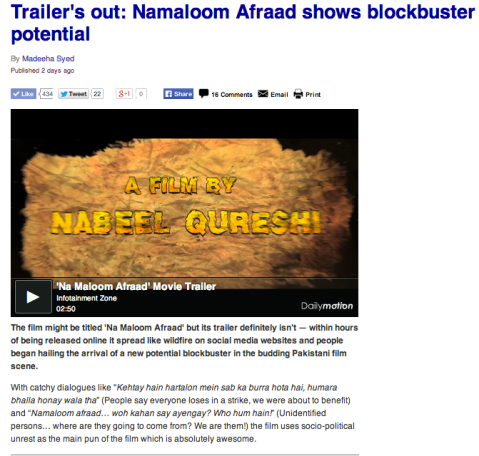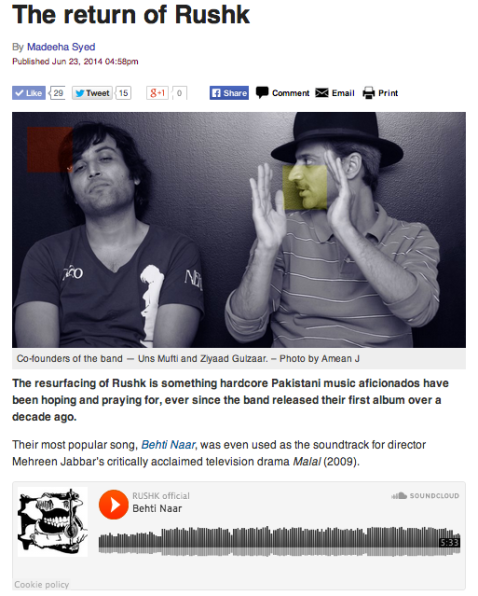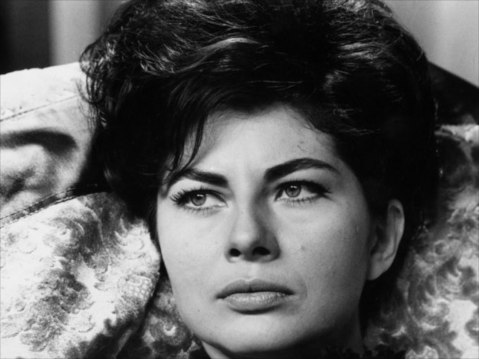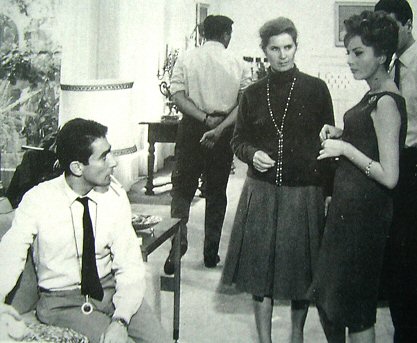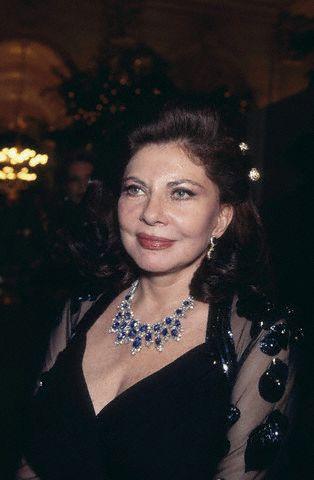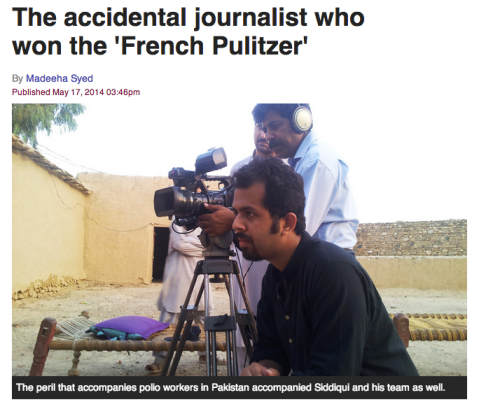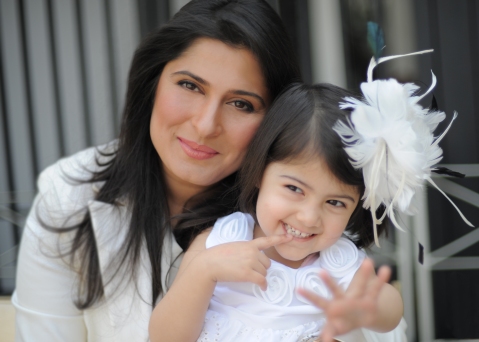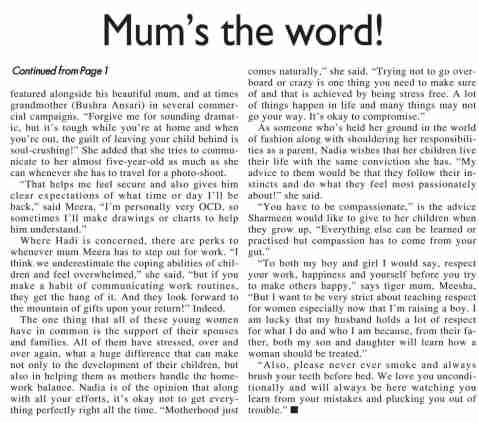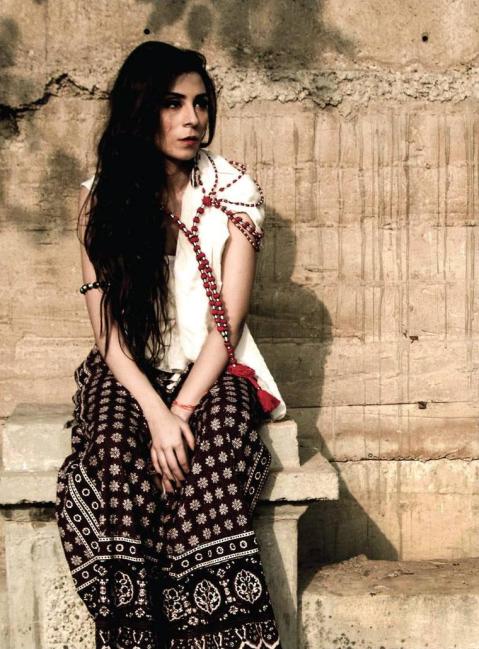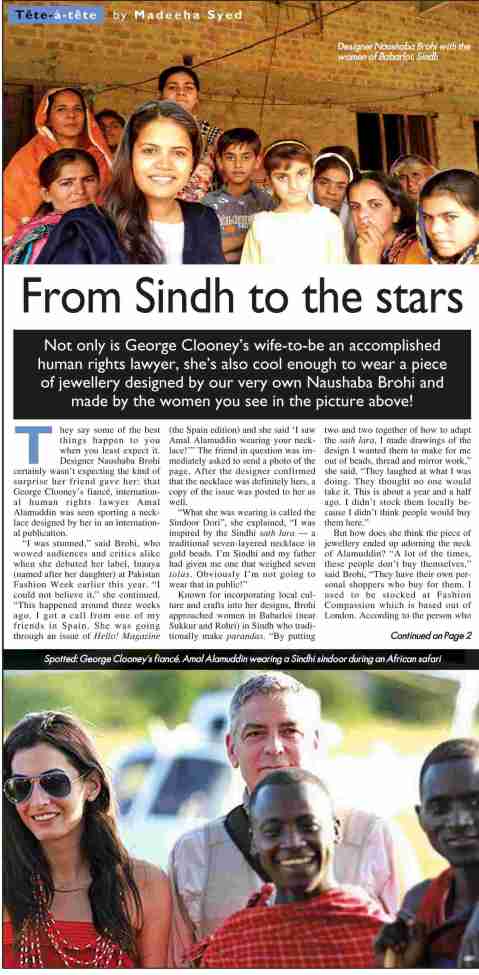Trailer’s out: Namaloom Afraad shows blockbuster potential
[Published on DAWN.COM — Click here or on the photo to access the article]
The return of Rushk
[Published on DAWN.COM — Click here or the photo for the article]
Eat, pray and… love your chef
They say the way to a man’s heart is through his stomach. That adage couldn’t be better suited to Pakistan’s Chef Zakir whose love for food has led him on numerous journeys far, far away from home… only to return armed with the flavours of the world
 Irish playwright and founder of the London School of Economics, George Bernard Shaw, hit the nail on the head when he said: “There is no sincerer love than the love of food.” As Pakistanis, food is our national pastime. It is the one thing that unites us as a country — other than cricket. No one understands that better than the chefs in this country.
Irish playwright and founder of the London School of Economics, George Bernard Shaw, hit the nail on the head when he said: “There is no sincerer love than the love of food.” As Pakistanis, food is our national pastime. It is the one thing that unites us as a country — other than cricket. No one understands that better than the chefs in this country.
Mohammad Zakir Quraishi or Chef Zakir as he’s known in Pakistan is a man so intensely devoted to his craft that, according to him, he sacrificed spending time with his friends, and often his family, or engaging in other recreational pursuits throughout his life just so he could perfect his art. “I don’t like playing any games or sports,” he said. “I don’t go out and socialise. I don’t have an interest in watching movies or listening to music or anything else… I just know how to cook. Food is my life.”
His love for food led him to spend many years travelling around the world, immersing himself in the culture of different countries and discovering the gastronomic varieties and tastes they had to offer and learning how to recreate them. “I would live with them,” stressed Chef Zakir. “I wouldn’t go and see and learn a recipe and come back. I would spend a long stretch of time living in a certain place and learning the intricacies of their food and taste.” His favourite region appears to the continent of Africa. He’s travelled to Zambia, Zimbabwe and Botswana to name a few countries from the region, and happily relates gastronomic anecdotes from there.
While in Botswana, Chef Zakir worked in the kitchen of several restaurants and hotels in the two years he spent in the capital, Gaborone. He even helped launch an Indian restaurant by the name of Mughulya. “The food they eat is very much like ours. The difference is that they don’t use the spices we do. They use raw vegetables and meat to get the extra flavour in their food. And they cook by using the fat of animals. They don’t add oil, butter or ghee to their food.
“There is this beautiful way in which they cook food in the Cayman Islands in the Caribbean,” related the chef excitedly. “They marinate raw meat overnight and the next day cover it with dough and place it inside burning coal to cook. And they cook it to a point that that dough on the outside is completely burnt. Then they place that on the side and whenever a customer arrives, they hand it to them in a plate.” The customer then takes a heavy rod-like utensil and taps the burnt layer of dough and it comes off, according to the chef, “like a pappar,” revealing the well-cooked, tender and juicy meat inside.
“In the international market they know me as Chef Mohammad because it was too difficult for them to pronounce Zakir right,” he said, “and they would often refer to me as Zak, which I wasn’t comfortable with. I would rather they pronounce my name correctly and Mohammad was something they could easily pronounce. So I go as Chef Mohammad whenever I travel outside Pakistan.”
He returned to Pakistan sometime in 2000 and began working in developing recipes and tastes for local hotels and launching several restaurants. Soon after his arrival, a friend from a local television network told him they needed a chef for a food programme. “He said he was a big fan of how I cooked prawns,” he related. “I went and did one show and the head of the network really liked the way I conducted it, especially as a professional chef, and he offered me a permanent spot. The first time I ever came on television screens was for the Indus TV network. I later moved on to ARY and then Hum TV.” He moved abroad for a brief period and upon his return, Hum TV asked him to join their network again on a newly launched food channel that had quickly caught the fancy of Pakistani audiences around the country, Masala TV. He consented and remained with the channel for around seven years. Chef Zakir currently hosts a cooking show in the mornings for Dawn News.
He is also a judge on the Pakistani version of the global television show MasterChef, an honour he considers a testament to how far he’s come as a chef. Speaking about the talent he’s seen in Pakistan so far, he says that at times participants on MasterChef Pakistan would produce food so beautifully refined and unique in taste that it would make the judges wonder what possible ingredients went into creating it.
One of the things MasterChef Pakistan and other cooking shows has done, in the chef’s opinion, is that it has made Pakistani audiences more aware of the sheer variety of foods out there, and has encouraged them to take up cooking. “It warms my heart to see this new-found interest in food. Now Pakistani audiences are familiar with basil, and the difference between different kinds of cheese and their use. They know how to get exotic ingredients because they’re being stocked at markets as well.”
With all this, does he miss cooking in a ‘real’ kitchen? “In my personal experience, once you’ve been a part of a certain profession, even if you move away from it you can’t really get it out of your system because by then it’s in your blood. So whenever I wasn’t in the studio, I would cook at home. My son has a restaurant; I would go there and stand in the kitchen. He would ask me not to. But I can’t help myself. This is my interest, my passion, my junoon… so I will follow it wherever it takes me.”
Chef Zakir decided very early on in his career that he wanted to aim for the stars. He wasn’t content with just having passable skills; he wanted to be the best. “My father was an incredible cook,” he related. “I would see the respect and attention he got from people for his skill and even as a child, I knew that I wanted that — more than that, in fact.”
Food is a family obsession, so to speak. Despite having sampled some of the best foods from around the world, Chef Zakir personally prefers the taste of his wife’s cooking. Two of his daughters take their passion for food from their father and are constantly developing recipes and experimenting at home. “We’re often the victims of their experiments,” laughed the chef. “They will sometimes wake me up from my nap just to get some feedback or insight into something they have made.” Needless to say, the love of good food and fine dining is what brings this family together.
[Newspaper view: Click for larger image]
A royal affair
On a cold February night in Tehran, a lady-in-waiting skillfully trimmed yards of fabric from the petticoat and trail of her lady’s bridal trousseau, just hours before the royal wedding was to take place. The wedding had already been delayed due to the ill-health of the bride and carrying her rather extravagant Christian Dior wedding ensemble was proving to be quite difficult for her. The dress contained over 37 yards of silver lamé, it had 20,000 feathers and 6,000 diamond pieces sewn in. A white Dior mink jacket accompanied the dress to protect the bride against cold. The year was 1951 and Soraya Esfandiari-Bakhtiari was about to marry the last Shah of Iran, Mohammad Reza Pahlavi.
It was love at first sight for Soraya and the Shah. In Oct 1950, the Queen Mother (Taj-ol-Moluk) had arranged for Soraya and her family to travel to Tehran from England where Soraya had gone to improve her English. She was already fluent in Persian, German and French. A dinner was immediately arranged for the two families to meet.
The Shah’s sister, Princess Shams, had told Soraya that her brother wasn’t particularly handsome. But when Mohammad Reza made his appearance, dressed in his favourite outfit — the uniform of a general of the Iranian Air Force — he appeared to be quite good looking. Soraya and the Shah spent much of the evening talking.
At 2am the same night, the Shah called Khalil Khan Esfandiari-Bakhtiari, Soraya’s father, to ask for her hand in marriage. Soraya gave her consent.
The announcement was made and her photograph was distributed to the press the very next day. As a symbol of their engagement, the Shah gave her a 22.37-carat diamond ring. Soraya was 18 and Mohammad Reza was 31 years old at that time.
The Shah had been briefly married before to Princess Fawzia Fuad of Egypt and had a daughter, Princess Shahnaz Pahlavi, with her. The marriage was short lived — lasting only six years.
The first two years of Shah and Soraya’s life were relatively uneventful, until 1953, when the Shah decided to sack his Prime Minister, Dr Mohammad Mossadegh, who had openly opposed the establishment of the Pahlavi dynasty as the rulers of Iran.
Fearing a public backlash, as Mossadegh was quite popular in Iran, he left with Soraya for Rome. The press descended on them during their stay there at the Hotel Excelsior. Soraya made a bit of a fashion statement in her famous polka-dotted strapless dress and large sunglasses.
After Mossadegh’s overthrow in a coup backed by the US and the UK, the couple immediately returned to Tehran.
The following years saw them travel all over the world on state business. They went to Russia, India, Britain, Turkey, Spain, Lebanon and the United States. When home, Soraya spent most of her time redecorating the royal palaces and attending charity events. Her father, Khalil Khan, was appointed ambassador to Germany. Soraya herself was half-German as her mother, Eva Karl, was from Berlin.
Soraya and Mohammad Reza did not have children together. In fact this was precisely the reason for their eventual separation. The pressure to produce an heir had always been omnipresent but it escalated after an assassination attempt on Shah’s life in 1949. He had initially named his brother, Ali Raza Pahlavi, as his heir but Ali Raza died in a plane crash in 1954. Although Soraya had sought treatment for her inability to conceive but none of the treatments were successful.
In July 1957, the couple discussed the survival of the dynasty in private and unable to agree on any solution they decided to part ways. Soraya left Tehran on Feb 14, 1958 taking her belongings and the presents she had received and moved into the Shah’s villa in Saint Moritz, Switzerland before moving back to Berlin with her parents. Several people from the Shah’s side tried to convince her to return and let the Shah take on a second wife, but she refused. They formally divorced on March 14, 1958. They were married for only seven years.
Soraya moved around Europe following her divorce until finally making Rome her home. There she met Dino de Laurentiis, an Italian film producer, who offered her a part in a film he was making, called Three faces of a woman. One of the film’s directors was Franco Indovina. Soraya agreed to be a part of it. The Shah, however, was reportedly so enraged upon hearing that his ex- wife would publicly feature in romantic scenes with other men that he bought all the copies of the film and ordered them to be destroyed. One copy that was with Soraya was eventually sold at an auction in Paris in May 2002. Soraya began having a passionate affair with Franco Indovina and they were together for five years before he too died a tragic death in a plane crash in May 1972.
Later in life, Soraya moved to Paris and spent her summers in Spain at the Villa Maryam. She died in Oct 2001 at the age of 69 due to a brain haemorrhage. Her funeral service was conducted at the American Church in Paris. Her brother, Bijan, also died suddenly in his hotel room before he could attend her funeral.
Over 400 people attended her funeral including dignitaries from many countries. Darya Dadvar, a famous Iranian soprano, performed a beautiful Ave Maria by Franz Schubert on the occasion. Her body was taken to Germany in November 2001 and was buried in her family tomb in Westfriedhof, Munich.
Though their relationship had ended, Mohammad Raza continued to provide for Soraya. She had received a large settlement that included land and farms. She had even been given a diplomatic passport, the privileges of which she enjoyed until the 1979 Iranian Revolution saw the overthrow of the Shah. She was then given a Moroccan diplomatic passport on the orders of King Hasan.
Mohammad Reza Pahlavi had also issued a special decree bestowing on Soraya the title of Imperial Princess for life. Thus, Soraya might have only been a royal consort for seven years, but she died a princess.
Newspaper view: [Click for larger image]
Juvenile offenders given computer training
KARACHI: Prison systems all over the world are slowly moving away from the ‘retribution-based’ model towards a system based on ‘rehabilitation and reformation’. And as children are considered easier to rehabilitate, it came as no big surprise that over a dozen juvenile offenders were equipped with computer knowledge during their term and awarded certificates on the completion of their course on Friday.
The Karachi Central Prison has introduced many educational programmes and art workshops targeting this class of inmates and the Friday certificates distribution ceremony organised by the Women Islamic Lawyers Forum in a newly constructed hall in the Young Offenders Industrial School was meant for those attaining two distinct levels of computer literacy — advanced and basic.
Members of the lawyers’ forum stated that they began their services in the prison by providing legal aid, but they soon realised it wasn’t enough to secure the release of juvenile offenders as they must be enabled to earn livelihoods after their release. It was for this reason that they began holding behavioural change workshops twice a week and introduced the computer programme .
Inspector General of Prisons Sindh Nusrat Hussain Manghan was also present at the ceremony as was the superintendent of women and juvenile jails, Sheeba Shah.
While highlighting the need for rehabilitation and reformation of inmates, Mr Manghan said they’d introduced similar programmes in all the prisons in Sindh. “Children are the future of this country. We would like for them to leave and achieve great things in their life. The objective of such programmes is to ensure that we don’t see them here again,” he said.
The young offenders between the ages of 16 and 18 were awarded the certificates. They appeared timid and extremely camera shy as they lined up to receive their documents.
It was announced that there were several who had already served out their term or had been released by the time the ceremony took place, and therefore arrangements were being made to deliver the certificates at their homes.
It was also explained that the certificate did not mention that the students gained their expertise while in prison so that the stigma associated with being jailed would not follow them once they were out.
Newspaper view: [Click for larger image]
Aorae: Stand up and listen
What do you get when you bring together the pioneer in Pashto rap with an artist who’s taken rap music to a whole new level in the country (and beyond)? You get:Aorae.
According to singer songwriter, Mustafa Kamal Khan of the Islamabad-based Pashto rap outfit, Fortitude, Aorae is Pashto for “Listen up! Or even ‘Hear me out!’ depending on what context you’re taking it in.”.
To read more, click here.
The accidental journalist who won the ‘French Pulitzer’
The Award
It was previously awarded only to one journalist a year until they relaxed their rules and included two. And then in 1985, a separate prize was included for audiovisual documentary.
Named after French writer and journalist, Albert Londres, who is credited for having ‘invented’ investigative journalism, the prize has been given out to the best in journalism since 1933. A jury of 19 journalists and winner(s) of the previous year select the recipient. The Albert Londres Prize is often dubbed as the ‘France’s Pulitzer.’
This year, the award went to 30-year-old Pakistani journalist Taha Siddiqui along with his colleagues Julien Fouchet and Sylvain Lepetit for their documentary, La guerre de la polio(The Polio War) for France 24. A shorter version in English can be viewed here. Siddiqui is the first non-French speaking journalist to have won this award.
To read more, click here.
Mum’s the word!
Can you have it all? We speak to mums in the spotlight about striking the perfect balance between parenting, work and more …
“I was thrilled to discover that I was going to be a mother!” said Meesha Shafi, the multi-talented powerhouse entertainer who has taken the country by storm. She felt ready to take on parenthood with her husband, musician and President of Pak MMA Fighting Alliance, Mahmood Rehman. “Both financially and emotionally, it was the perfect time to welcome a new member into our family. I think it can probably be overwhelming when a marriage is weak or not settled, but we were more than prepared to welcome our daughter. That was three years ago, and we have since welcomed a brand new baby boy into our family as well.”
She opens up about the experience of parenting. “The thought of having two children, both at a highly-dependent age can be daunting, especially for a working mother like me,” she said. “But my brother and I were raised by an exceptionally strong, simple working mother. I give her full credit for what I think is a job well done. I learnt a lot about balancing life and work from my mum. From her, I’ve seen that it’s all very possible. When you learn from the best, it gives you a lot of courage and faith in yourself.” The ‘mum’ in question is, of course, none other than veteran television actor Saba Hamid.
The idea of becoming a parent can be a little daunting, even for someone who’s spent a considerable amount of time reporting in conflict zones and winning global awards for being badass and brave. “I was thrilled at the thought of becoming a mother,” said Sharmeen Obaid-Chinoy, Pakistan’s first (and only) Oscar winner, “Having a child is one of the most precious privileges one can be lucky enough to experience. As the news sunk in, there were definitely moments of nervousness and anxiety, predominantly because there was so much to learn. It can be a bit intimidating for a first-time parent. I have realised that each mother has a different way of going about things, and each parent-child relationship is different — it’s all about finding your groove and going with it!”
Not everyone is prepared to welcome motherhood though, especially when it comes unplanned. One of Pakistan’s most well-known faces in the world of fashion, supermodel-turned-designer Nadia Hussain Khan was shocked when she discovered that just three months into her marriage with hubby Atif Khan, she was pregnant. “We had planned to wait for two years!” she said, “So yes, there were plenty of fears and reservations about my life as a mother and how that would affect my freedom, work, body … pretty much everything. No, I was not excited.” Despite the initial scare, motherhood must have won over Nadia in the end because she has three adorable children. While having the last one, she celebrated motherhood by making numerous appearances on the fashion runway, complete with a very large baby bump.
She isn’t the first mother to ‘come out’ with her pregnancy. Back when she was having Janevi, Meesha shot for the cover of a local monthly lifestyle magazine clad in black tights, tank top and high heels, showing off her baby bump. The cover caused quite a bit of a stir in social media circles where some applauded her for being ‘pregnant and proud’ and others considered the display, well, ‘shameless’.
The photo and the resulting controversy took one back to the 1991 cover of Vanity Fair which featured a handbra nude photograph of a seven-month pregnant Demi Moore, which also caused quite a bit of a stir among the public when it first came out. Having said that, what is it about a pregnant woman ‘coming out’ that makes people uncomfortable is a topic for another article.
Meesha is of the opinion that there’s no room for being childish or irresponsible once you are a parent. “The biggest challenge is setting healthy examples in everyday life because your children are always absorbing what is going on around them,” said Meesha on the trials and tribulations of parenthood, “Sometimes when you don’t feel very stable and mature in your own skin and just want to whine and complain over stupid things, the thought of setting an example kicks in. And that really helps keep both my husband and I grounded.” That can certainly be a challenge.
“Saying goodbye to your carefree years forever is the most challenging,” she adds. “Having said that, there is absolutely no other role in life that is so rewarding.”
On the other hand, for Sharmeen, the biggest challenge of parenthood boils down to one tiny word, “The ability to say ‘no’,” she exclaimed. “Even when it is heartbreaking to do so!”
For Nadia, it all comes down to finding the right balance. “It’s to make sure that my kids study well and have a good work-play balance so they grow up with well-rounded personalities,” she said.
“Motherhood is unarguably the toughest and most rewarding job you’ll ever have!” exclaimed model Meera Ansari, whose son Hadi, had an early introduction into the world of modelling. As a toddler, he’s been featured alongside his beautiful mum, and at times grandmother (Bushra Ansari) in several commercial campaigns. “Forgive me for sounding dramatic, but it’s tough while you’re at home and when you’re out, the guilt of leaving your child behind is soul-crushing!” She added that she tries to communicate to her almost five-year-old as much as she can whenever she has to travel for a photo-shoot.
“That helps me feel secure and also gives him clear expectations of what time of the day I’ll be back,” said Meera, “I’m personally very OCD, so sometimes I’ll make drawings or charts to help them understand.”
Where Hadi is concerned, there are perks to whenever mum Meera has to step out for work. “I think we underestimate the coping abilities of children and feel overwhelmed,” she said, “but if you make a habit of communicating work routines, they get the hang of it. And they look forward to the mountain of gifts upon your return!” Indeed.
The one thing that all of these young women have in common is the support of their spouses and families. All of them have stressed, over and over again, what a huge difference that can make not only to the development of their children, but also in helping them as mothers handle the home-work balance. Nadia is of the opinion that along with all your efforts, it’s okay not to get everything perfectly right all the time. “Motherhood just comes naturally,” she said. “Trying not to go overboard or crazy is one thing you need to make sure of and that is achieved by being stress free. A lot of things happen in life and many things may not go your way. It’s okay to compromise.”
As someone who’s held her ground in the world of fashion along with shouldering her responsibilities as a parent, Nadia wishes that her children live their life with the same conviction she has. “My advice to them would be that they follow their instincts and do what they feel most passionately about!” she said.
“You have to be compassionate,” is the advice Sharmeen would like to give to her children when they grow up, “Everything else can be learned or practised but compassion has to come from your gut.”
“To both my boy and girl I would say, respect your work, happiness and yourself before you try to make others happy,” says tiger mum, Meesha, “But I want to be very strict about teaching respect for women especially now that I’m raising a boy. I am lucky that my husband holds a lot of respect for what I do and who I am because, from their father, both my son and daughter will learn how a woman should be treated.”
“Also, please never ever smoke and always brush your teeth before bed. We love you unconditionally and will always be here watching you learn from your mistakes and plucking you out of trouble.”
Newspaper view: [Click for larger image]
From Sindh to the stars
They say some of the best things happen to you when you least expect it. Designer Naushaba Brohi certainly wasn’t expecting the kind of surprise her friend gave her: that George Clooney’s fiancé, international human rights lawyer Amal Alamuddin was seen sporting a necklace designed by her in an international publication.
“I was stunned,” said Brohi, who wowed audiences and critics alike when she debuted her label, Inaaya (named after her daughter) at Pakistan Fashion Week earlier this year. “I could not believe it,” she continued. “This happened around three weeks ago. I got a call from one of my friends in Spain. She was going through an issue of Hello! Magazine (the Spain edition) and she said ‘I saw Amal Alamuddin wearing your necklace!’” The friend in question was immediately asked to send a photo of the page. After the designer confirmed that the necklace was definitely hers, a copy of the issue was posted to her as well.
“What she was wearing is called the Sindoor Dori”, she explained, “I was inspired by the Sindhi sath lara — a traditional seven-layered necklace in gold beads. I’m Sindhi and my father had given me one that weighed seven tolas. Obviously I’m not going to wear that in public!”
Known for incorporating local culture and crafts into her designs, Brohi approached women in Babarloi (near Sukkur and Rohri) in Sindh who traditionally make parandas. “By putting two and two together of how to adapt the sath lara, I made drawings of the design I wanted them to make for me out of beads, thread and mirror work,” she said, “They laughed at what I was doing. They thought no one would take it. This is about a year and a half ago. I didn’t stock them locally because I didn’t think people would buy them here.”

Spotted: George Clooney’s fiancé, international human rights lawyer Amal Alamuddin wearing the Sindhi sindoor during an African safari
But how does she think the piece of jewellery ended up adorning the neck of Alamuddin? “A lot of the times, these people don’t buy themselves,” said Brohi, “They have their own personal shoppers who buy for them. I used to be stocked at Fashion Compassion which is based out of London. According to the person who owns that enterprise, Amal bought the Sindoor Dori from there.”
Being featured in an international publication certainly has its own perks back home. “Last year, Vogue India picked up one of my jewellery pieces, the Zenith necklace, also made in seven layers,” she said, “When that came out, suddenly everyone wanted it. And now, suddenly everyone wants this.”
The designer who incorporates ethnic designs into her work has plans of expanding into other regions as well. That includes the troubled province of Balochistan. “I’m a hardcore desi,” she explained, “For me; it’s not just about Sindh. Right now I’m sampling in Khuzdar, Balochistan. I’ve been trying to do this for several months now. These women are scared. They shut down operations when they see their families being blown up. So it’s difficult.”
How has the experience been so far? “I’m happy to work with anyone who needs and wants to work,” she responded, “Balochistan is the only place where I’m working through an organisation, Water Environment and Sanitation Society (WESS) and their sister concern Women Economic Empowerment Balochistan, because I can’t travel there and they can’t travel here. Their main focus is something else, but as a by-product of their setup, they work with women on the revival of crafts.”
The distinction here is that where she might collaborate with charitable organisations, unlike other designers who are doing similar work, her label itself is not one. “I don’t run an NGO or a charitable organisation,” she said, “I don’t have investors or anything. This is a for-profit business. I live off this. It has to feed them (the people working for the organisation), myself and then grow as well.”
From what she’s seen so far, what does she think of ethnic Baloch designs? “The geometry is stunning,” she responded excitedly, “To me they’re all absolute mathematicians. Usually when we do embroidery or patchwork, we draw a stencil (chappa) first as a guide. These women don’t work with chappa, they count the thread in the fabric, the number of stitches they had to make as a measure and end up producing work with absolute symmetry. It’s very refined. They’re all luxury goods — I’m averse to term ‘craft fare’ when it comes to this. They’re luxury goods to me.”
The designer, who currently stocks in five locations: Karachi, Lahore, Islamabad, Dubai and Washington D.C., would like to clarify that although a lot of people have termed her work as ‘ethnical fashion’, the truth is, it’s not. “Let me tell you this, I can’t afford the luxury of being ethical,” she said, “I am a socially-conscious person, but I do the best that I can. My carbon footprint is crazy because I drive everywhere. I don’t always know where my fabric is coming from — whether here or China for example. I’m the first to buy local wherever I can buy local.”
“I like to think it’s about building bridges to prosperity, in the sense that sure, culture is a huge proponent in what I’ve set out to do, but, perhaps people trump that,” she concluded thoughtfully, “Inaaya means empathy; it’s got more to do with our collective consciousness. The logo was inspired by that, our tag line: Together, forward, forever.”
Trend watch: Tribal muse
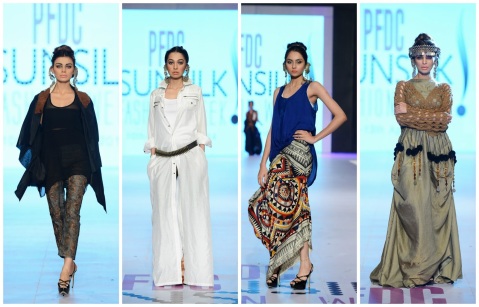
The love for Afghan tribal jewellery is now global. Last year, British jewellery designer Pippa Small found her way to the streets of Kabul in search for inspiration for her next collection for a design house called Monsoon. Small’s association with Afghanistan began with Turquoise Mountain Foundation — built by British MP Rory Stewart to encourage Afghan craft — back in 2006. Her clientele includes Nicole Kidman, Sophie Dahl and Uma Thurman.
Under the brand ‘Aayenda’ (‘future’ in Dari) Afghan jewellery made its way to London Fashion Week last year courtesy of Future Brilliance — a charity set up by Sophia Swire, a British business woman. Swire is credited for introducing the Pashmina to the West after she spotted Lahori socialites wearing it at an event back in the 1990s. She also helped establish a school for jewellers and gem cutters through Turquoise Mountain.
Jewellery making is a part of Afghan culture — a country rich in emeralds, rubies, tourmalines and lapis lazuli. With the discovery of the Bactrian Hoard in 1978, Afghanistan’s original tribal design can be traced back to the the first century BC. Its influence can be found in other Central Asian as well as Greek and Turkish tribal jewellery.
Afghan jewellery enjoyed immense popularity in Pakistan in the late 1970s and throughout the 1980s. Designers such as Iman Ahmed from the Body Focus Museum and Maria Butt also chose to adorn their collections with Afghan tribal jewellery at the fashion week held last week in Lahore. Walk into any bazaar and you’ll see a surge of shops selling these tribal designs. A quick search online reveals more and more businesses catering to clientele interested in acquiring them — and there are many. It’s safe to assume that Afghan jewellery is not only in vogue on the international runway, but back home as well.
Newspaper view: [Click for larger image]
